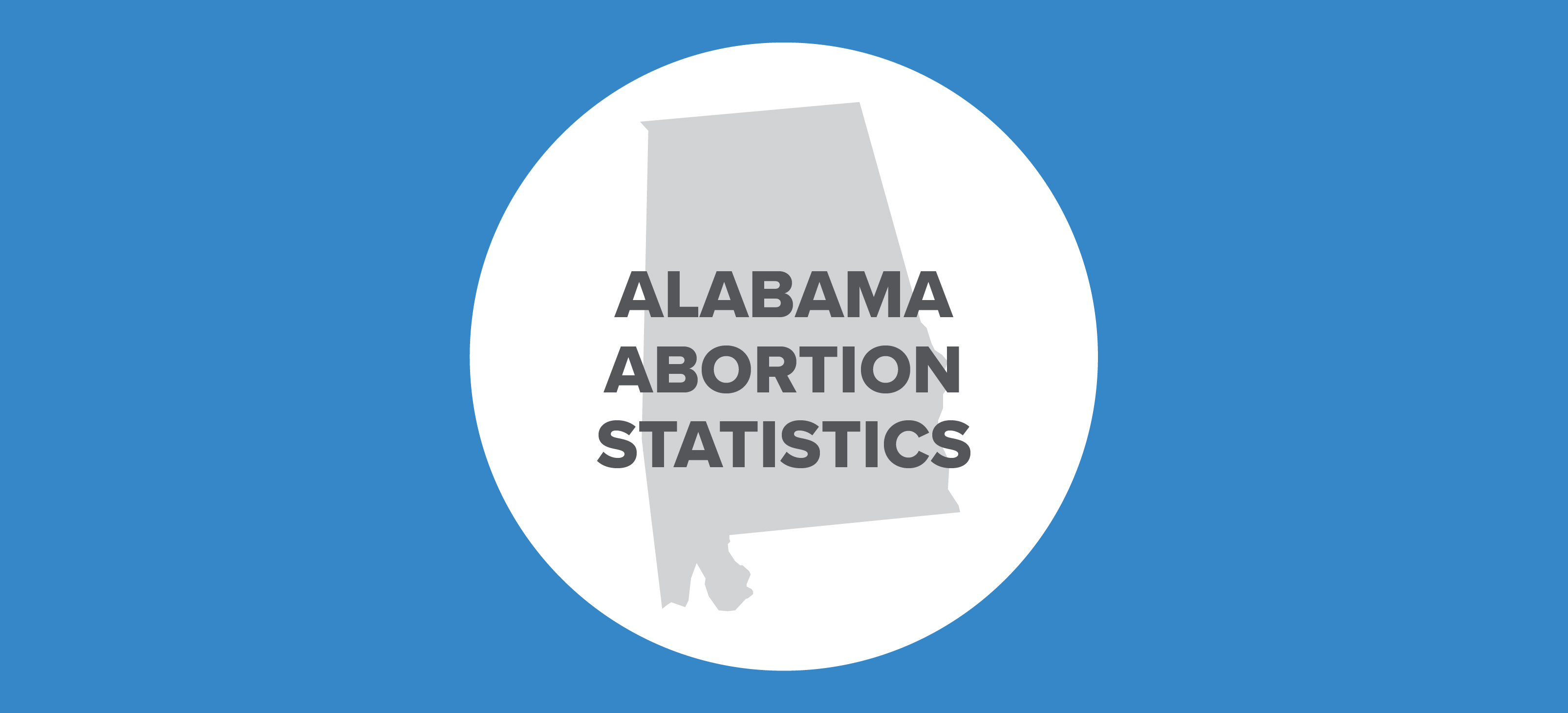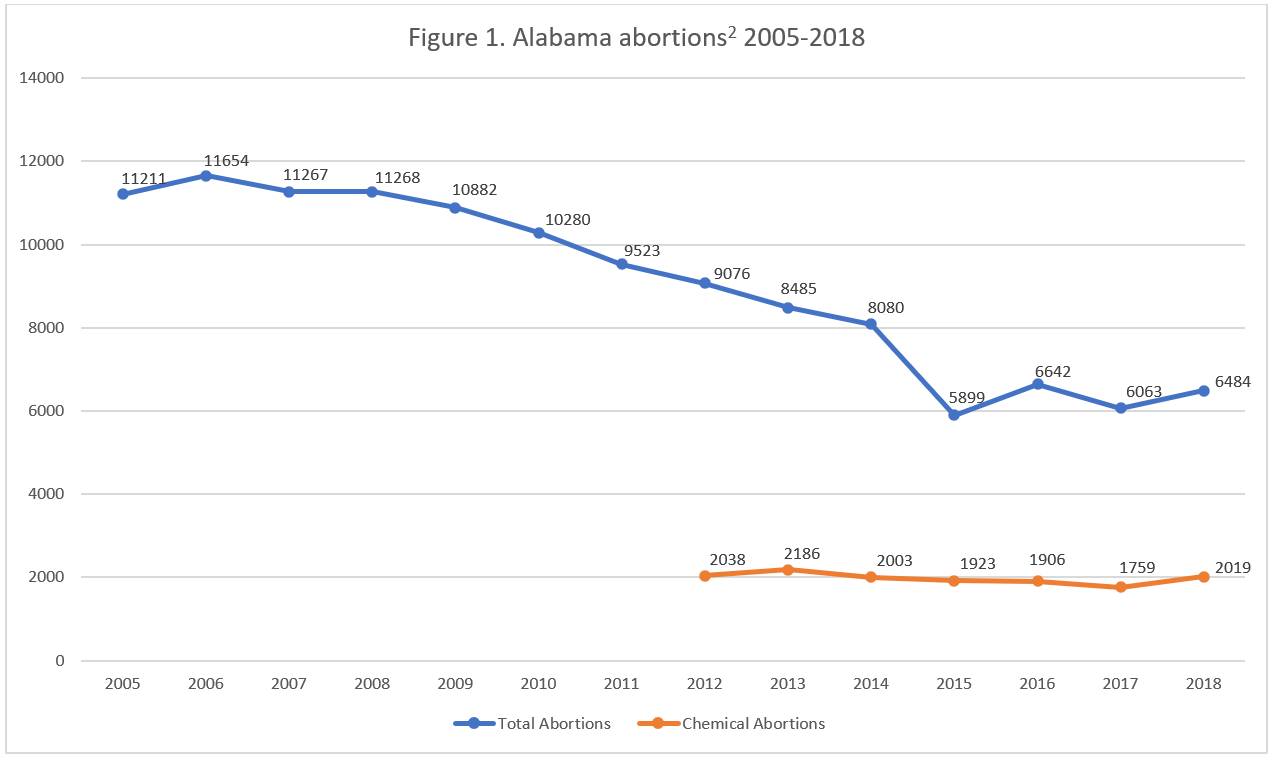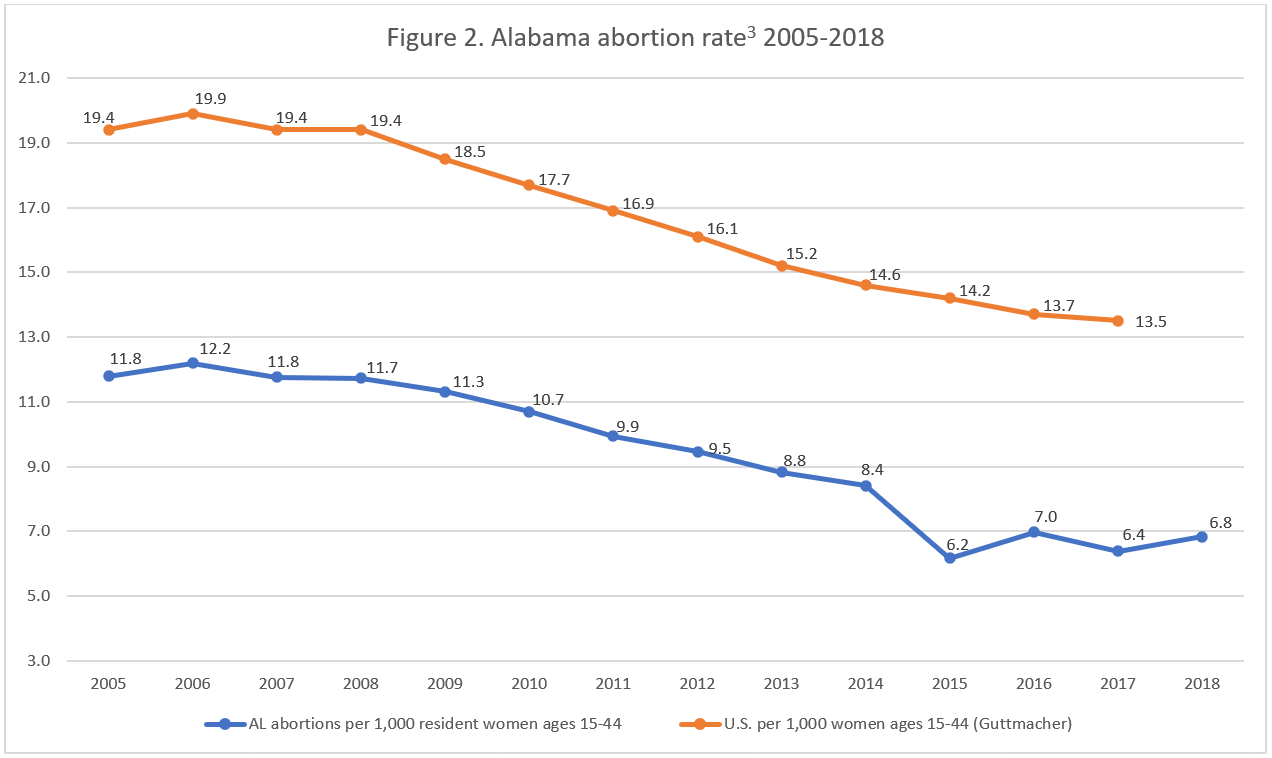Abortion Reporting: Alabama (2018)

Alabama’s 2018 abortion report, published by the Alabama Department of Public Health in March 2020, shows that abortions increased from the previous year.
Statistics and Changes in Alabama Abortions, 2017-20181

Abortion Totals and Trends
In 2018, there were 6,484 abortions reported in Alabama, of which 31 percent were chemical abortions (Fig. 1). Total Alabama abortions increased by seven percent from 2017, while chemical abortions increased by 15 percent. Despite this increase, the Charlotte Lozier Institute estimates that Alabama’s abortion rate in 2018 was just over 6.8 abortions per 1,000 women of childbearing age, up seven percent from a little under 6.4 in 2017 but still much lower than the national rate (Fig. 2). There were 7,381 abortions performed on Alabama residents, both in Alabama and in other states, an increase of nine percent from the year before. However, the report cautions that not all states report abortions back to Alabama, so this total is likely an undercount of the actual number of abortions performed on Alabama residents.
State Report Summary
Residents
There were 7,381 abortions reported to have been performed on Alabama residents in 2018. Sixty-one percent of the Alabama women undergoing abortions were in their twenties, with 31 percent ages 20 to 24 and 30 percent ages 25 to 29. Twenty-six percent were in their thirties, and three percent were age 40 or older, while 10 percent were under the age of 20. A majority of the abortions (60 percent) were on black women, even though black women compose just 32 percent of Alabama’s population of women of childbearing age. A third of the abortions were performed on white women, and three percent were on women of other races. Four percent of the abortions were performed on women of unknown race.
Eighty-seven percent of the abortions were performed on unmarried Alabama residents, compared to just 11 percent on married women and two percent on women of unknown marital status. Most of the women had finished high school. Thirty-seven percent reported high school as their highest level of education, and 53 percent had more than a high school education, while nine percent had not finished high school. Many of the women had previously given birth: 28 percent had one prior live birth and 35 percent had two or more. Sixty-six percent had never had an abortion before. Twenty-two percent had one previous abortion and 11 percent had more than one.
Twenty-one percent of the abortions occurred at six weeks of gestation or earlier. Thirty-four percent were performed between seven and eight weeks and 20 percent from nine to 10 weeks. Nine percent were performed between 11 and 12 weeks and another nine percent between 13 and 15 weeks of gestation. Four percent were reported from 16 to 19 weeks and not quite one percent (60 abortions) at 20 weeks, when unborn babies can feel pain. Another 58 abortions occurred at 21 weeks of gestation or later.
Occurrence
Alabama separately reports the number of abortions occurring in the state regardless of whether they were performed on residents or nonresidents. There were 6,484 abortions reported in Alabama in 2018. Similar to the abortions performed on Alabama residents, a majority of the abortions reported in Alabama (61 percent) were on women in their twenties. Twenty-six percent were on women in their thirties, and three percent were on women in their forties or older. Ten percent of the abortions were on women under the age of 20. Alabama requires parental consent before an abortion may be performed on a minor girl. There were 229 minors who obtained abortions in Alabama in 2018; of these, 226 received parental consent, and three got court orders waiving the parental consent requirement. The report does not state whether there were any instances of a court declining to grant a parental consent waiver. A high majority of the abortions performed in Alabama (62 percent) were on black women, compared to 35 percent on white women and three percent on women of other races.
Alabama uses probable postfertilization age to date the pregnancies of all women obtaining abortions in the state, including both residents and nonresidents. In contrast, the pregnancy lengths of Alabama residents who get abortions both in Alabama and in other states are reported using gestational age. Probable postfertilization age measures pregnancy from the date of conception and is approximately two weeks less than gestational age, which dates pregnancy from the first day of a woman’s last menstrual period. In 2018, 53 percent of the abortions performed in Alabama occurred at six weeks postfertilization or earlier (approximately eight weeks of gestation). Twenty-two percent were performed between seven and eight weeks postfertilization and 10 percent between nine and 10 weeks. Seven percent of the abortions reported in Alabama occurred between 11 and 12 weeks postfertilization, five percent from 13 to 15 weeks, and four percent between 16 and 19 weeks. One abortion was performed at 20 weeks, two at 21 weeks, and one at 25 weeks postfertilization (around 27 weeks of gestation). Postfertilization age was not reported for one abortion.
Probable postfertilization age was determined in advance of all but one abortion, which was performed due to a medical emergency (incomplete/inevitable abortion with persistent vaginal bleeding). Ultrasound was used to determine postfertilization age for all but two abortions. Of the four abortions reported at 20 weeks of postfertilization or later, one was performed because of severe preeclampsia or eclampsia, two because of inevitable abortion and premature rupture of membranes, and one for an unspecified reason. Abortions at or after 20 weeks are supposed to be performed using a procedure that will give the unborn baby a chance to live, unless doing so would increase risk to the mother. According to the annual report, the abortion due to severe preeclampsia or eclampsia was not performed using a procedure that would provide the unborn baby with the best chance of survival, although the report does not provide any additional information regarding which procedure was used.
Sixty-two percent of the abortions reported in Alabama were performed using suction curettage, and 31 percent were chemical abortions. Six percent were performed using dilation and evacuation. There were 12 electric vacuum aspiration procedures, 11 induction abortions, and three sharp curettage abortions. Two abortions were performed via hysterectomy and one using hysterotomy. Four abortions were performed using unreported methods. In one case, an intra-fetal injection was used to kill the unborn baby before the abortion.
Abortions were reported at five Alabama facilities in 2018, of which three were abortion centers and two were hospitals. The vast majority of the abortions occurred at the abortion centers (51 percent at West Alabama Women’s Center, 28 percent at Alabama Women’s Center for Reproductive Alternatives, and 20 percent at Reproductive Health Services, Inc.). Just four abortions occurred in hospitals. Two were performed at USA Children and Women’s Center, and two occurred at Brookwood Medical Center. Neither of Planned Parenthood’s two Alabama centers reported any abortions.
Human Life Protection Act
In 2019, Alabama passed the Human Life Protection Act to limit abortion except in cases of risk to the mother’s life or a major bodily function or when the unborn baby has a “lethal anomaly”. The law was slated to go into effect in November 2019, but the abortion industry sued, and the law was blocked by a temporary injunction in October 2019 while the case proceeds. However, Alabama is defending the Human Life Protection Act in the U.S. District Court for the Middle District of Alabama, and the governor has expressed hope that the law will inspire the U.S. Supreme Court to reconsider its decision in Roe v. Wade, which rendered Alabama’s original law prohibiting abortion unenforceable.
State Ranking
In CLI’s 2016 survey of abortion reporting nationwide, Alabama’s reporting scored in the top half of the list at 12th best. The Yellowhammer State reports useful information that many other states do not, such as the number of abortions performed at each facility in the state. Still, Alabama could improve its reporting by providing more details on the travel of women seeking abortions, including the states to which Alabama residents go for abortions and the states from which women come to Alabama for abortions. The report could also include demographic information (such as pregnancy history, marital status, and level of education) for all women obtaining abortions in Alabama, including those from other states.


- This graphic represents the percentage change in Alabama’s abortion rate rather than the absolute change as depicted in earlier abortion reporting summaries.
- The 2012 abortion report is the earliest with information on the types of abortion procedures performed in Alabama.
- Starting with the 2018 abortion reports, abortion rates are calculated by the Charlotte Lozier Institute to allow for easier state-to-state and year-to-year comparisons. Rates were calculated by CLI using population estimates from the United States Census Bureau. The rates were calculated using the following formula: (total number of abortions performed in Alabama ÷ number of resident women ages 15-44) x 1,000. Rates may differ slightly from previous CLI articles due to revised population estimates.
























